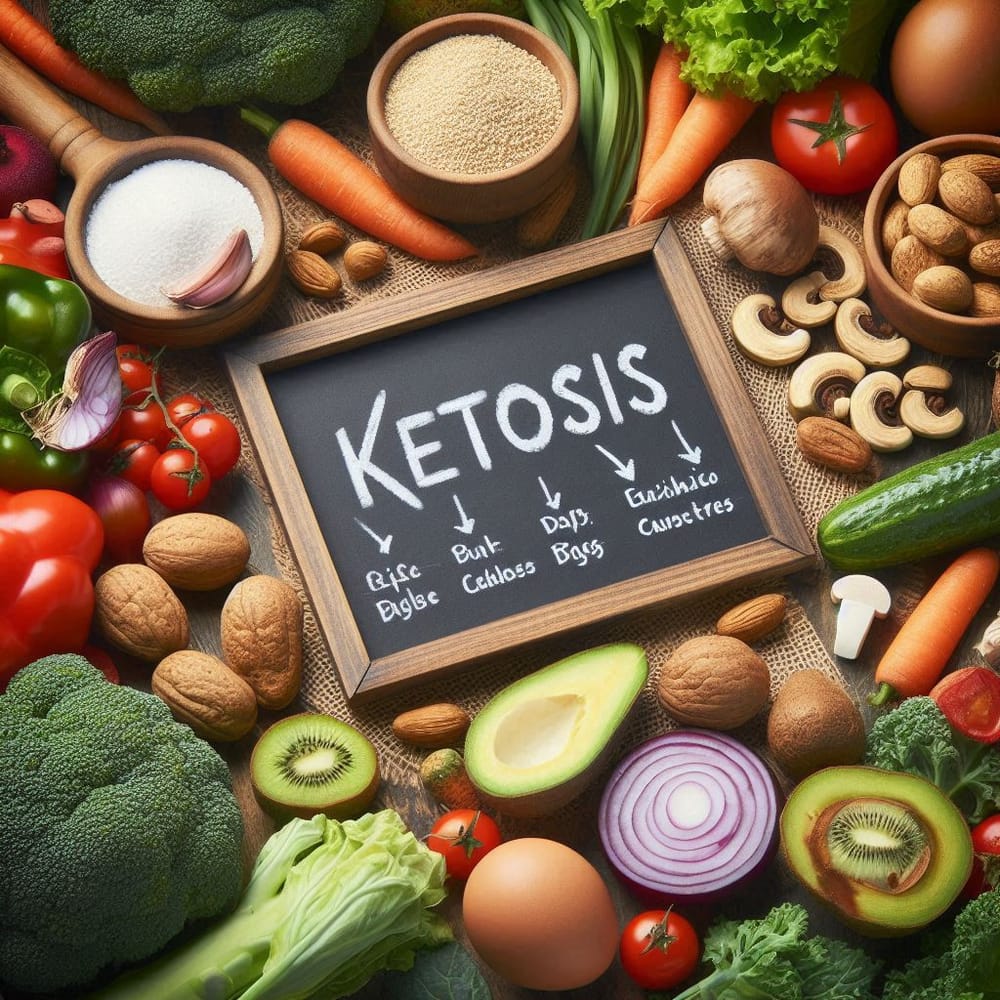Ketosis
is a fascinating metabolic state that occurs when the body transitions from using carbohydrates as its primary energy source to burning fat for fuel. This shift typically happens when carbohydrate intake is significantly reduced, prompting the liver to convert fats into molecules called ketones. These ketones then serve as an alternative energy source, particularly for the brain and muscles. The science behind ketosis lies in the body’s natural adaptation to periods of low carbohydrate availability. When glycogen stores in the liver and muscles are depleted, the body ramps up fat oxidation, leading to the production of ketones. This process not only enhances fat burning but also helps stabilize blood sugar levels and improve energy efficiency. By understanding the intricate mechanisms of ketosis, individuals can leverage this metabolic state to support weight loss, boost mental clarity, and enhance overall physical performance.
How Ketosis Works
When the body enters ketosis, it shifts from relying on carbohydrates to utilizing fats as its primary energy source. This process begins when carbohydrate intake is significantly reduced, leading to a depletion of glycogen stores in the liver and muscles. In response, the liver starts converting fatty acids into ketone bodies, which are then released into the bloodstream and used by various tissues, including the brain and muscles, as an alternative fuel source. This metabolic state not only promotes fat burning but also helps in maintaining energy levels and mental clarity, making it a key strategy for weight management and overall health improvement.
The Role of Ketones
Ketones play a crucial role in the state of ketosis. They are produced in the liver from fatty acids when glucose availability is low. The three primary types of ketone bodies are acetoacetate, beta-hydroxybutyrate, and acetone. These molecules are highly efficient energy sources that can be used by most cells in the body. Beta-hydroxybutyrate, in particular, is a potent source of energy for the brain, which typically relies on glucose. By providing an alternative fuel, ketones help to preserve muscle mass and prevent the breakdown of proteins for energy, which is a common issue in other forms of calorie restriction.
Ketosis vs. Glycolysis
Ketosis and glycolysis are two distinct metabolic pathways that the body uses to generate energy. Glycolysis is the process by which glucose is broken down in the cells to produce energy. It is the body’s default energy pathway when carbohydrates are readily available. In contrast, ketosis is the metabolic state where the body burns fat for fuel in the absence of sufficient carbohydrates. While glycolysis is rapid and efficient in providing quick energy, ketosis offers a more sustained energy supply by tapping into fat reserves. This difference makes ketosis particularly effective for long-term energy maintenance and weight loss, as it encourages the body to use stored fat, leading to a reduction in body fat percentage and improved metabolic health.
Benefits of Ketosis
Ketosis offers a multitude of benefits that make it a popular choice for those seeking improved health and fitness. One of the most notable benefits is weight loss. By shifting the body's primary fuel source from carbohydrates to fat, ketosis effectively burns stored fat, leading to significant and sustainable weight loss. This metabolic state also helps in reducing appetite and curbing cravings, which further supports weight management efforts.
Another significant advantage of ketosis is improved mental clarity. Ketones provide a stable and efficient energy source for the brain, which can enhance cognitive function, focus, and concentration. Many individuals on a ketogenic diet report experiencing sharper mental clarity and better overall brain performance.
Enhanced energy levels are also a key benefit of ketosis. Unlike the energy spikes and crashes associated with carbohydrate-based diets, ketosis provides a steady supply of energy throughout the day. This is because fat, the body's primary fuel source in ketosis, is more abundant and longer-lasting than glycogen stored from carbohydrates. As a result, individuals often feel more energetic and less fatigued.
Finally, ketosis plays a crucial role in better blood sugar control. By significantly reducing carbohydrate intake, the ketogenic diet helps stabilize blood sugar levels and improve insulin sensitivity. This is particularly beneficial for individuals with type 2 diabetes or those at risk of developing the condition. The steady release of energy from fat also prevents the rapid spikes and drops in blood sugar levels that can occur with high-carb diets, promoting overall metabolic health.
Starting a Ketogenic Diet
Embarking on a ketogenic diet requires careful planning and a clear understanding of what to eat, foods to avoid, and how to structure your meals. Here is a detailed guide to help you get started:
What to Eat:
On a ketogenic diet, your primary focus should be on consuming high-fat, moderate-protein, and very low-carbohydrate foods. Essential foods to include are:
- Meats: Beef, pork, lamb, poultry, and fatty fish like salmon and mackerel.
- Dairy: Cheese, butter, cream, and full-fat yogurt.
- Fats and Oils: Olive oil, coconut oil, avocado oil, and butter.
- Low-Carb Vegetables: Leafy greens, broccoli, cauliflower, zucchini, and bell peppers.
- Nuts and Seeds: Almonds, walnuts, chia seeds, and flaxseeds.
- Beverages: Water, unsweetened tea, and coffee.
Foods to Avoid:
To achieve and maintain ketosis, it’s crucial to eliminate high-carb foods from your diet. Foods to avoid include:
- Sugary Foods: Candy, soda, cakes, and pastries.
- Grains and Starches: Bread, pasta, rice, and cereals.
- High-Carb Fruits: Bananas, grapes, apples, and mangoes.
- Legumes: Beans, lentils, and chickpeas.
- Processed Foods: Fast food, processed snacks, and foods with added sugars.
- Sugary Beverages: Fruit juices, soft drinks, and sports drinks.
Sample Meal Plan:
Here is a simple ketogenic meal plan to guide you through your first few days:
- Breakfast: Scrambled eggs cooked in butter with a side of avocado and spinach.
- Lunch: Grilled chicken salad with mixed greens, olive oil, and avocado dressing.
- Dinner: Baked salmon with roasted broccoli and cauliflower, drizzled with lemon butter.
- Snacks: A handful of almonds, cheese slices, or a small serving of full-fat yogurt.
By adhering to these guidelines and focusing on nutrient-dense, high-fat foods, you can successfully start and sustain a ketogenic diet, reaping its numerous health benefits.
How Do I Know When I Am in Ketosis?
Knowing if you're in ketosis involves recognizing several signs and symptoms your body exhibits when it shifts from using glucose to fat as its primary energy source. Here are some common indicators:
- Increased Ketone Levels: You can measure ketone levels in your blood, urine, or breath. Blood ketone meters are considered the most accurate, showing whether you have reached the desired ketone range (usually 0.5–3.0 mmol/L).
- Weight Loss: Initial rapid weight loss due to water weight, followed by steady fat loss, can indicate ketosis.
- Bad Breath: Known as "keto breath," this is a result of increased acetone, a type of ketone, which can cause your breath to smell fruity or metallic.
- Increased Urination: As your body uses up glycogen, which binds water, you'll likely experience frequent urination, especially in the early stages.
- Reduced Appetite: Many people in ketosis experience reduced hunger and cravings due to the appetite-suppressing effects of ketones.
- Improved Mental Clarity and Focus: Once your brain adapts to using ketones for energy, you might notice better cognitive function and sustained focus.
- Boosted Energy Levels: After the initial adaptation period, you may feel more energetic and less fatigued.
- Digestive Changes: Some people may experience changes in bowel habits, such as constipation or diarrhea, as their body adjusts to a higher fat intake.
If you are unsure, using a combination of these signs along with measuring ketone levels can provide a clearer indication of whether you are in ketosis.
Common Challenges and How to Overcome Them
Starting a ketogenic diet can be rewarding, but it also comes with its set of challenges. Here’s a detailed look at some common issues and how to effectively manage them:
Keto Flu:
Many beginners experience the “keto flu” during the initial phase of the diet, typically within the first week. Symptoms may include headaches, fatigue, dizziness, nausea, and irritability. These occur as your body adapts to burning fat for fuel instead of carbohydrates. To alleviate keto flu symptoms:
- Stay Hydrated: Drink plenty of water to help flush out toxins and maintain hydration.
- Increase Salt Intake: Add more salt to your food or drink broth to replenish electrolytes.
- Gradual Transition: Slowly reduce carbohydrate intake over a week or two instead of making an abrupt switch.
Maintaining Electrolyte Balance:
Electrolyte imbalances are common on the ketogenic diet due to reduced insulin levels, which cause the kidneys to excrete more sodium and water. To maintain proper electrolyte balance:
- Sodium: Add a pinch of sea salt to your meals or drink broth.
- Potassium: Eat potassium-rich foods such as avocados, spinach, and nuts.
- Magnesium: Incorporate magnesium-rich foods like leafy greens, nuts, and seeds, or consider a magnesium supplement.
Managing Cravings:
Cravings for high-carb foods can be intense, especially in the beginning. Here are strategies to manage and overcome these cravings:
- Stay Full: Eat enough healthy fats and proteins to keep yourself satiated.
- Healthy Snacks: Keep keto-friendly snacks on hand, such as cheese, nuts, or boiled eggs.
- Mindful Eating: Practice mindful eating techniques to recognize hunger cues and avoid emotional eating.
- Plan Ahead: Prepare meals and snacks in advance to prevent impulsive eating of non-keto foods.
By understanding these common challenges and implementing these strategies, you can navigate the ketogenic diet more smoothly and increase your chances of long-term success.
Health Considerations
When considering a ketogenic diet, it's crucial to understand its health implications and determine whether it's suitable for your specific situation. Some individuals should avoid ketosis or seek medical advice before starting, such as pregnant or breastfeeding women, people with a history of eating disorders, individuals with gallbladder issues, those with kidney disease, and diabetics on medication due to its significant effects on blood sugar levels. Potential side effects include the "keto flu," which manifests as headaches, fatigue, nausea, and irritability, along with digestive issues like constipation or diarrhea, bad breath due to ketone production, and leg cramps caused by electrolyte imbalances. The long-term health effects of a ketogenic diet are still being studied, with concerns about heart health due to high saturated fat intake, potential nutrient deficiencies from restricting carbohydrate-rich foods, possible impacts on bone health, and the challenge of maintaining such a restrictive diet over time, which can lead to yo-yo dieting and weight cycling. Therefore, considering these health factors is essential to making an informed decision about adopting a ketogenic diet, and consulting with a healthcare provider is recommended, especially for those with underlying health conditions.
FAQs About Ketosis
What is ketosis?
Ketosis is a metabolic state where the body burns fat for fuel instead of carbohydrates, producing ketones as a byproduct.
Is a ketogenic diet a good idea?
A ketogenic diet can be effective for weight loss and blood sugar control, but it's essential to consult with a healthcare provider to determine if it's suitable for you.
Does the ketogenic diet really work?
Yes, the ketogenic diet has been shown to help with weight loss, improve metabolic health, and control blood sugar levels in many individuals.
Will keto make me lose fat?
Yes, the ketogenic diet can help you lose fat by promoting fat burning and reducing hunger, which can lead to a caloric deficit.
What is a custom keto diet?
A custom keto diet is a personalized meal plan tailored to your dietary preferences, health goals, and lifestyle, designed to help you achieve ketosis effectively.
Who should avoid a keto diet?
Individuals with kidney disease, pregnant or breastfeeding women, people with a history of eating disorders, and those with certain metabolic disorders should avoid a keto diet or consult a healthcare provider before starting.
How long should you do keto?
The duration of following a ketogenic diet varies based on individual goals and health conditions. Some follow it short-term for weight loss, while others adopt it as a long-term lifestyle change.
What food is not allowed on keto?
Foods to avoid on a keto diet include high-carb items like bread, pasta, rice, sugary foods, starchy vegetables, and most fruits.



